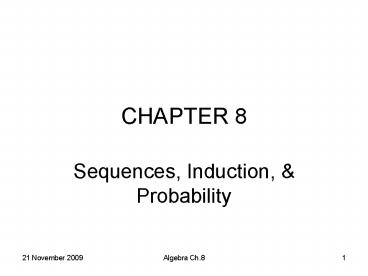Sequences, Induction, - PowerPoint PPT Presentation
1 / 19
Title:
Sequences, Induction,
Description:
Use recursion formulas. Use factorial notation. Use summation notation. 11/7/09. Algebra Ch.8 ... Use the formula for the sum of an infinite geometric series ... – PowerPoint PPT presentation
Number of Views:21
Avg rating:3.0/5.0
Title: Sequences, Induction,
1
CHAPTER 8
- Sequences, Induction, Probability
2
8.1 Sequences Summation Notation
- Objectives
- Find particular terms of sequence from the
general term - Use recursion formulas
- Use factorial notation
- Use summation notation
3
What is a sequence?
- An infinite sequence is a function whose domain
is the set of positive integers. The function
values, terms, of the sequences are represented
by - Sequences whose domains are the first n integers,
not ALL positive integers, are finite sequences.
4
Recursive Sequences
- A specific term is given.
- Other terms are determined based on the value of
the previous term(s) - Example
5
Find the 1st 3 terms of the sequence
- 1)4, 5/2, 6
- 2)4, 5/2, 1
- 3)1, 2, 3
- 4)4, 5, 6
6
Summation Notation
- The sum of the first n terms, as i goes from 1 to
n is given as - Example
7
8.2 Arithmetic Sequences
- Objectives
- Find the common difference for an arithmetic
sequence - Write terms of an arithmetic sequence
- Use the formula for the general term of an
arithmetic sequence - Use the formula for the sum of the first n terms
of an arithmetic sequence
8
What is an arithmetic sequence?
- A sequence where there is a common difference
between every 2 terms. - Example 5,8,11,14,17,..
- The common difference (d) is 3
- If a specific term is known and the difference is
known, you can determine the value of any term in
the sequence - For the previous example, find the 20th term
9
Example continued
- The first term is 5 and d3
- Notice between the 1st 2nd terms there is 1
(3). Between the 1st 4th terms there are 3
(3s). Between the 1st nth terms there would
be (n-1) 3s - 20th term would be the 1st term 19(3s)
10
The sum of the 1st n terms of an arithmetic
sequence
- Since every term is increasing by a constant (d),
the sequence, if plotted on a graph (xthe
indicated term, ythe value of that term), would
be a line with slope d - The average of the 1st last terms would be
greater than the 1st term by k and less than the
last term by k. The same is true for the 2nd
term the 2nd to last term, etc - Therefore, you can find the sum by replacing each
term by the average of the 1st last terms
(continue next slide)
11
Sum of an arithmetic sequence
- If there are n terms in the arithmetic sequence
and you replace all of them with the average of
the 1st last, the result is
12
Find the sum of the 1st 30 terms of the
arithmetic sequence if
- 1) 81
- 2) 3430
- 3) 2430
- 4) 168
- Answer sum 2430
13
8.3 Geometric Sequences Series
- Objectives
- Find the common ratio of a geometric sequence
- Write terms of a geometric sequence
- Use the formula for the general term of a
geometric sequence - Use the formula for the sum of the 1st n terms of
a geometric sequence - Find the value of an annuity
- Use the formula for the sum of an infinite
geometric series
14
What is a geometric sequence?
- A sequence of terms that have a common multiplier
(r) between all terms - The multiplier is the ratio between the (n1)th
term the nth term - Example -2,4,-8,16,-32,
- The ratio between any 2 terms is (-2) which is
the value you multiply any term by to find the
next term
15
Given a term in a geometric sequence, find a
specified other term
- Example If 1st term3 and r4, find the 14th
term - Notice to find the 2nd term, you multiply 3(4)
- To find the 3rd term, you would multiply 3(4)(4)
- To find the 4th term, multiply 3(4)(4)(4)
- To find the nth term, multiply 3(4)(4)(4)
(n-1 times) - 14th term
- (in a geometric sequence, terms get large
quickly!)
16
Sum of the 1st n terms of a geometric sequence
17
What if 0ltrlt1 or -1ltrlt0?
- Examine an example
- If 1st term6 and r-1/3
- Even though the terms are alternating between
pos. neg., their magnitude is getting smaller
smaller - Imagine infinitely many of these terms the terms
become infinitely small
18
Find the Sum of an Infinite Geometric Series
- If -1ltrlt1 and r not equal zero, then we CAN find
the sum, even with infinitely many terms
(remember, after a while the terms become
infinitely small, thus we can find the sum!) - If and n is getting very
large, then r raised to the n, recall, is getting
very, very smallso small it approaches zero,
which allows us to replace r raised to the nth
power with a zero! - This leads to
19
Repeating decimals can be considered as infinite
sums
- Example Write .34444444as an infinite sum
- Separate the .3 from the rest of the number
- .3444.. .3 .044444..
- .044444.. .04 .004 .0004 .0004
- This is an infinite sum with 1st term.04,r.1
- .3444.































